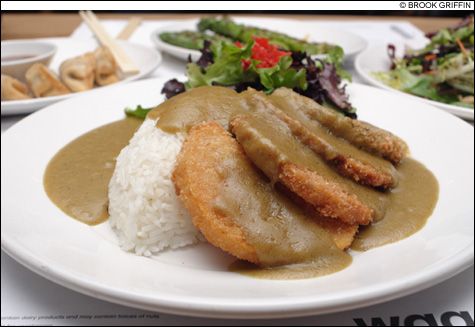
KATSU IF YOU CAN: The yasai katsu curry at Wagamama is a deep-fried treat. |
| Wagamama | 57 JFK Street, Cambridge | Open Mon-Wed, 11:30 am–10 pm; Thurs–Sat, 11:30 am–11 pm; and Sun, Noon–10 pm | AE, DI, MC, VI | Beer and wine | No valet parking; $2-off validation at harvard square garage | Ramped street-level access via winthrop street | 617.499.0930 |
I’m not supposed to like Wagamama, but I do. I’m not supposed to like chains, and Wagamama is a UK-based chain with 79 restaurants in 10 countries. (The Harvard Square and Quincy Market locations are the first US outlets.) I hate loud restaurants, and Wagamama is a long, open room with an open kitchen, louder than most Harvard University dining halls. I also hate standing in lines, so I should gripe that Wagamama doesn’t take reservations. But since it’s fast and large, the lines are never long. Still, why pay more here when authentic Japanese food is as close as Porter Square?Because Wagamama is quick, tasty, and fun. Never mind that most of the flavor comes from salt and hot pepper, with dashes of sweet. That’s part of the fun, and also part of the fusion, since Wagamama is a Japanese noodle house with a lot of Malaysian-British influence.
Food comes out whenever it’s ready and is delivered by random servers. But the Wagamama staff seems to have this organized, so everyone gets the right food fast — even if the main dishes sometimes precede appetizers (here called “Side dishes: these are not appetizers”).
Of the “side dishes” I had, I was most impressed by the grilled asparagus ($6.50). The dry heat concentrates the flavor, and the five spears, with their Japanese togarashi (sesame-pepper-salt) seasoning, are as irresistible as popcorn. Duck gyoza ($6.95) brings baked dumplings with thin skins and meaty fillings, and comes with an excellent sweet, rich, and hot dip. Raw salad ($3.95) may be just greens, but it’s dressed up by a fish-sauce-based dressing and crisp onion bits.
As for the entrées, chicken ramen ($9.50) is what you’ll want when fall’s cold strikes. There’s not a lot of broth, but what is there is clear and light — a Chinese-type stock with slices of grilled chicken breast, reconstituted dried bamboo, a smattering of scallions, and side of baby spinach leaves. The classic way to eat this dish is with chopsticks; using your dominant hand, pick up noodles and other bits and place them in the ladle-like soup spoon. But conventional forks and spoons are also available.
Chicken kare lomen ($11.75) has the same general arrangement as the ramen, with a thick broth based on coconut milk, lemongrass, and galangal, similar to the Thai coconut-chicken soup. It’s hotter, more complex, and less sweet and aromatic than the Thai version, but another sprinkle of cilantro and a wedge of lime make it sing.
Yaki soba ($9) is fried noodles made to taste like drier fried rice with egg, bits of chicken, tiny shrimp, scallion, bean sprouts, peppers, and a garnish of sesame seeds and hard bits of shallot or onion. It’s the most addictive piece of fast food I’ve let myself near in years. Teriyaki steak soba ($13.75) adds a small grilled steak in slices almost small enough for chopsticks. But this dish isn’t as interesting, despite the addition of bok choy and snow peas. I should add that both of these soba are based on ramen noodles, not buckwheat noodles, which I first associate with soba.